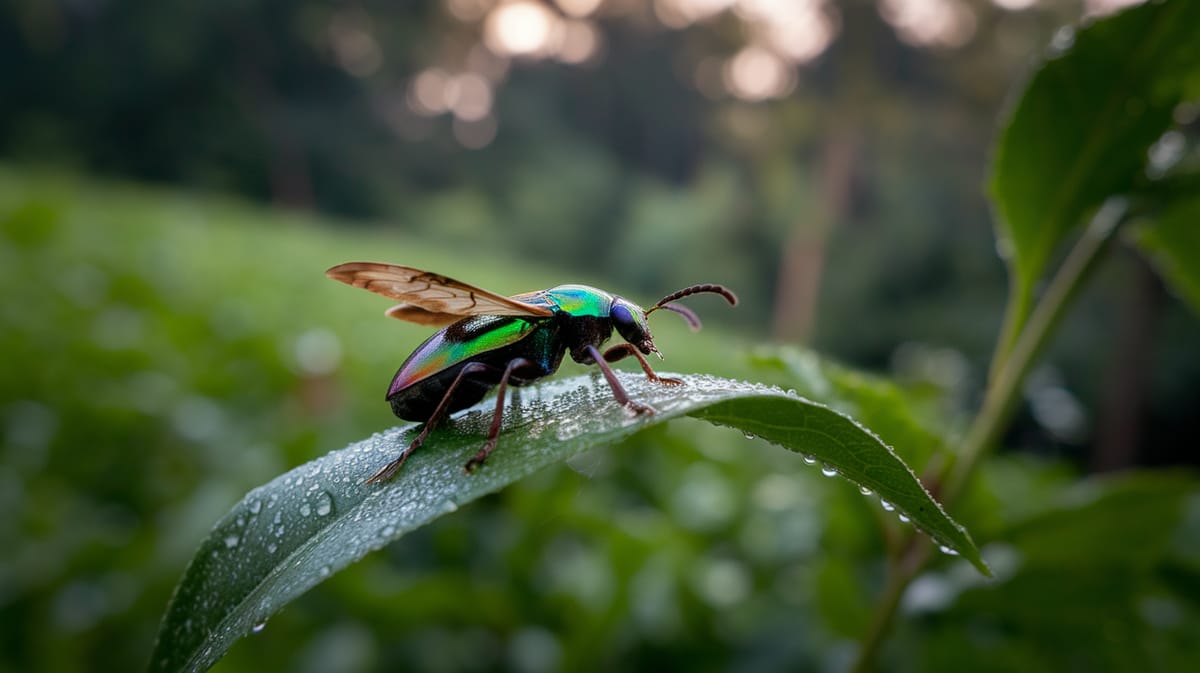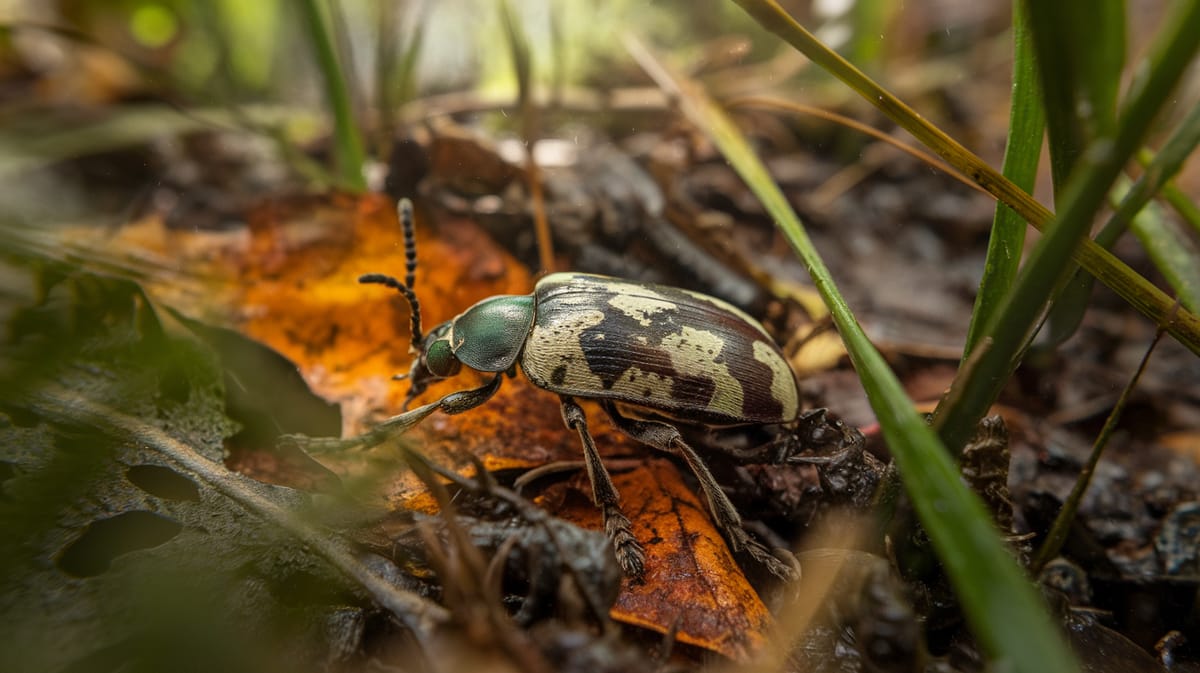Flower Beetle
Vibrant and captivating, the Flower Beetle thrives amid blossoms, playing a vital role in pollination and ecosystem balance. Its iridescent colors and swift movements make it a garden gem.

Key Insights at a Glance
Did You Know?
Taxonomy & Classification
Flower beetles boast vivid colors and robust bodies, key traits that assist in pollination and habitat adaptation. Let's understand the evolutionary journey and classification of these remarkable pollinators.
Species Diversity
Pachnoda includes over 100 species, thriving in various ecosystems across Africa, highlighting their adaptability and ecological significance.
Ancient Origins
Flower beetles evolved around 200 million years ago, adapting through climatic shifts and contributing to plant pollination over millennia.
Lifecycle and Growth
A remarkable journey of transformation from Egg to Adult.
Egg
Female Flower Beetles lay eggs in decaying plant matter, providing nutrients and protection for developing larvae.
Larva
Larvae, resembling grubs, feed voraciously on decaying organic material, growing rapidly before transitioning to the next stage.
Pupa
Within a protective cocoon, the larva undergoes metamorphosis, transforming into an adult beetle.
Adult
Adults emerge with vibrant colors, feeding on nectar and pollen while playing a role in pollination.
Dietary Habits
A vibrant feeder with diverse tastes, this insect thrives on fruits, nectar, and opportunistic plant matter.
| DIET TYPE | DESCRIPTION |
|---|---|
| Primary Diet | Primarily consumes ripe fruits and tree sap, using its strong mandibles to access food. |
| Secondary Diet | Often feeds on pollen and nectar from flowering plants, aiding in pollination as it forages. |
| Occasional | Occasionally consumes decaying plant matter and fungi, adapting diet based on environmental availability. |

Behaviour and Adaptations
Discover the fascinating adaptations that enable the Flower Beetle to thrive in diverse environments.
Pollen Collection
Efficiently gathers pollen using specialized mouthparts, aiding in pollination.
Colorful Camouflage
Vibrant colors blend with flowers to avoid predators.
Defensive Secretion
Produces chemicals to deter threats and prevent predation.
Ecosystem Impact
Supporting biodiversity through the Flower Beetle's ecological roles.
Pollination Partner
Aids in pollination by visiting a variety of flowering plants.
Decomposer Role
Breaks down decomposing plant material, enriching soil nutrients.
Prey for Predators
Serves as a food source for birds and small mammals.
Conservation Challenges
Understanding and addressing the major threats to Flower Beetle populations.
Habitat Loss
Deforestation and urbanization are reducing the natural habitats of Flower Beetles.
Pesticide Use
Pesticides can drastically reduce Flower Beetle numbers and disrupt ecosystems.
Climate Change
Altered weather patterns affect the breeding and survival of Flower Beetles.
Frequently Asked Questions
How long do Flower Beetle live?
Flower Beetles typically live for about three to six months, depending on environmental conditions and food availability. Their lifespan can vary by species, with some living longer in captivity if provided with optimal care.
What do Flower Beetle eat?
Flower Beetles mainly feed on nectar, pollen, and fruit. Their diet can include other plant materials. They are important pollinators due to their attraction to flowers and their feeding habits.
Are Flower Beetle poisonous?
Flower Beetles are not poisonous to humans. They do not possess venom or toxic substances that pose a threat. They are generally harmless and play a beneficial role in ecosystems.
Are Flower Beetle endangered?
Most Flower Beetle species are not endangered. They are widespread and common in various habitats. However, habitat loss and environmental changes can impact local populations. Conservation efforts focus on preserving their natural habitats.
What do Flower Beetle symbolize?
Flower Beetles are often symbols of transformation and renewal. Their presence in gardens signifies healthy ecosystems and biodiversity. They are appreciated for their role in pollination and contributing to plant health.
Do Flower Beetle bite?
Flower Beetles do not bite humans. They have mandibles for feeding on plant material but are not aggressive. They are more interested in flowers and fruits rather than interacting with people.
What color are Flower Beetle?
Flower Beetles come in a variety of colors, including bright greens, yellows, reds, and metallic hues. Their vibrant colors often help them blend into the flowers they visit, offering some protection from predators.
Does a Flower Beetle have wings?
Yes, Flower Beetles have wings. They possess two pairs: forewings that are hard and protective, and hindwings used for flying. This allows them to travel between flowers as they feed and pollinate.
What does a Flower Beetle look like?
Flower Beetles are small to medium-sized with a compact, oval-shaped body. They often have bright, shiny exoskeletons and clubbed antennae. Their coloration helps them camouflage among flowers and foliage.
Is a Flower Beetle an insect?
Yes, a Flower Beetle is an insect. It belongs to the order Coleoptera, characterized by its hardened forewings and chewing mouthparts. Like all insects, it has three body segments: head, thorax, and abdomen.
Related Insects
Discover insects with similar characteristics to Flower Beetle - including shared habitats, diets, and taxonomic classifications
Share this profile
Help others discover Flower Beetle
